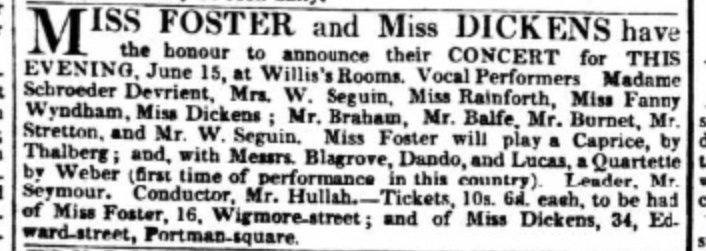Women at the Academy in the mid-nineteenth century
While the first intake of female students to the Academy have disappeared into the mists of time, in the second intake, names that make it into public consciousness begin to appear. Fanny Dickens (1810-1848) is an example, entering the Academy in 1823. She studied both singing and piano, as most of the early students did, although it was singing that formed the basis of her career, piano being the side dish. She would go on to share platforms with other musicians such as her husband, Henry Burnett, German soprano Anna Schröder-Devrient, and French singer Rosalbina Caradori-Allan – until, of course, marriage and motherhood sharply curtailed her performing activities, and tuberculosis took her at the tragically early age of 38.
Another extremely famous figure was soprano Anna Bishop (1810-1884), who appeared in these pages last week. She studied at the Academy a few years after Dickens, starting on piano with Ignaz Moscheles before her extraordinary soprano voice was discovered, leading to her switch in focus. It is impossible to do justice here to Bishop’s colourful life; I am an enormous admirer of her talent, dedication and capacity for sheer hard work, and she will appear in these pages yet again later in the year. Her pianism, one infers, was not of the highest order, and thus she missed out on any of the early scholarships, such as the King’s Scholarships instated in 1834. The first two female students to win this, their musicianship now lost to the mists of time, were Catherine Halls and Louisa Hopkins. (Poor Catherine had to suffer from an inept press, who mixed up her last name with that of George Hall, one of the two male winners.)
By the next decade, female singers who had studied at the Academy were becoming well-known on the stages of the country and the world, such as Mary Shaw (1814-1876), Charlotte Sainton-Dolby (1821-1885), and Georgiana Poulter (dates unknown). Next to become known were the pianists, including the “child prodigy” Elizabeth Jonas (c1825-1877) who was “patronized by Her Royal Highness the Princess Augusta” and admitted to the Academy at the age of eleven in 1836 to study with Ignaz Moscheles and Thomas Attwood. Kate Loder (1825-1904) and Augusta Amherst Austen (1827-1877) were amongst these numbers; both also were organists who held positions in London churches. We also see the beginning of female students at the Academy who wanted to be known first as composers, rather than seeing this as an extra string to their bow. Clara Macirone (1821-1914) was one such musician. Her prolific letters to family members demonstrate that her performances were much more vehicles for her own music than they were pianistic displays. Another was Julia Woolf (1831-1893), composer of song and piano pieces, as well as an operetta, Carina, which by 1888 was “working itself into a genuine success at the Opèra Comique by reason of tuneful, if not very original, music, and chiefly and foremost by Mlle. Camille D’Arville’s artistc and fascinating singing and acting in the principal rôle,” as a contemporary review described.
Many of these women were able to sustain a good musical career, something we forget in our haste to draw them from shadows that are not as long as we might think. Those shadows do exist – Luise le Beau wrote in her autobiography of the extra-hard work that women had to take on, still to be ignored in the higher echelons of music culture. But they are not quite the shape we imagine, and they are not as all-encompassing as is often assumed, especially if we are willing to forego a cultural hierarchy that places public venues and public critical judgement at the top. Contrary to what it may seem, this can render these women even more invisible to succeeding generations – we still have a tendency for our eyes to slide over names that appear in programmes, as being available and thus not needing our help. But as any current composer will tell you, it’s the second performance that’s the hardest to procure. And why is one performance ever enough, when we are up against works with vast reception histories, of performances that occupy an entire spectrum of expertise, thus offering a rich, multi-faceted interpretation?
Of course, the style of music that many of these composers engaged with is often now seen as anachronistic. We have a deep suspicion of Victoriana, as I have already highlighted in the review of Dora Bright’s much later concerto. The complex nature of the friction between the death of Romanticism and the influence of the ‘long’ nineteenth century, coupled with a dawning discomfiture around the physical aspect of musicmaking in classical traditions, makes us wary of the unfettered sentimentality of some of this music. Indeed, sentimentality has come to be a pejorative term, not to mention at times aligned with contempt for the feminine, seen as sitting firmly in the same aesthetic. It’s a good way of dismissing all those nineteenth-century women who wrote songs to words that make us uncomfortable now. They must be “bad” composers, because the feeling they (deliberately) engender in the listener seems no longer viable.
Here’s a performance of one of Kate Loder’s piano works, Voyage Joyeux.



